Items tagged with 'animals'
Today's moment of bird
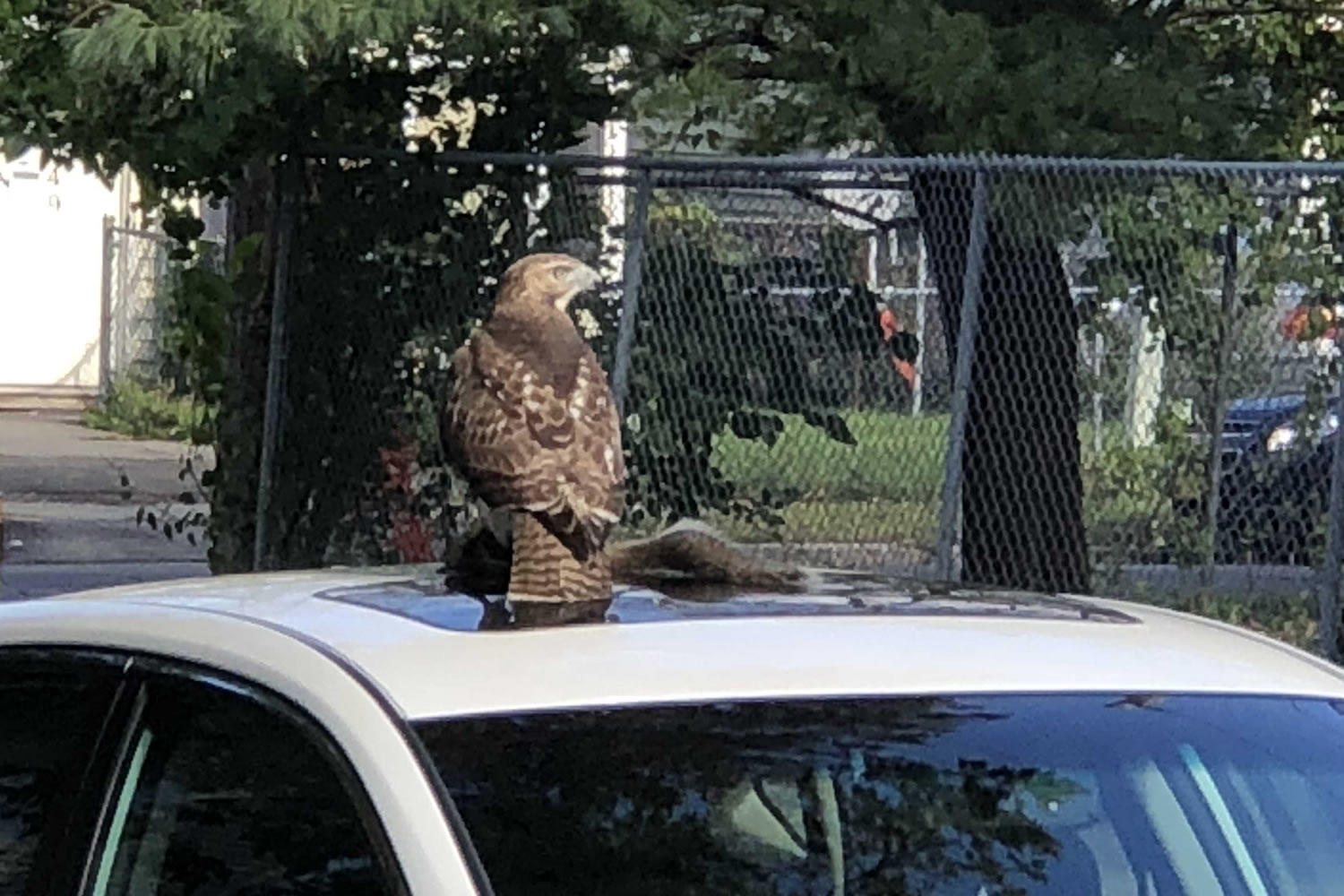
Margaret sent along this pic: "I saw this on Lark Street [Tuesday] between Clinton and Sheridan streets. Awesome urban hunter. Poor squirrel."
We've been surprised how often we've seen hawks hunting for squirrels in various Albany neighborhoods. Two years ago a hawk swooped right by while we we were walking along Myrtle Ave in Pine Hills, narrowly missing a squirrel in the street. But on two other occasions we've seen hawks successfully grab their prey.
Seeing that happen always instills a sense of awe at the speed and silence involved -- mixed with a tiny bit of "hmm, maybe next time it's me."
If the hawks and crows ever join forces, it's over.
Also: Someone really should have explained to the bird that Hawk Street is a few blocks over.
(Thanks, Margaret!)
Bat in the house? Capture it.
A state Depatment of Health video about how to capture a bat in a home.
From the folder marked "flying mammals and did you just see that... no, over there... oh, crap" and an Albany County press release:
Albany County Executive Daniel P. McCoy today is reminding residents to protect themselves from rabies by safely capturing any bat found in their home and bringing it to the Albany County Department of Health to have it tested for the disease and avoid any unnecessary vaccinations.
The County Department of Health has received multiple calls in recent months from residents concerned about potential exposure to rabies due to contact with bats, which is typical during the spring and summer months. ...
County residents are encouraged to use the below steps to safely capture any bats in their homes so they can be tested for rabies in a lab. If you are unable to trap it, you should be vaccinated at the Albany County Department of Health at 175 Green Street, Albany, NY 12202.
• Use caution
• If indoors, close all windows, room and closet doors, turn on the lights and wait for the bat to land.
• While wearing heavy gloves approach the bat slowly and carefully and cover the bat with a pail, coffee can, or similar container.
• Slide a piece of cardboard or lid under the container to trap the bat inside and tape the container shut.
Residents can "batproof" their home with polypropylene bird netting, fly screening, sheet metal, wood or various caulking compounds to close or cover openings that allow entry for bats to roost. House bats can pass through crevices as thin as a pencil.
As the press release notes, a small percentage of bats have rabies, but it's hard to tell which ones do by appearance and the consequences can be serious.
No. No. No. No. No. No. No.
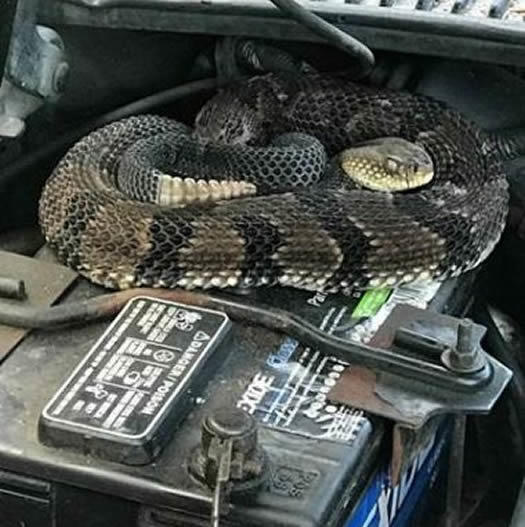
And to repeat: No. Nope. No. No. No. / photo: NYSDEC
Tucked in at the end of a state Department of Environmental Conservation digest of agency police officer encounters -- titled "Strange Rattle in the Engine - Delaware County":
On June 11, Lt. Nate Ver Hague and ECO Mark Vencak responded to a complaint of a rattlesnake resting on an engine block in the town of Hancock. The complainant told them that he had opened the hood of his car to jump start the vehicle and heard the distinctive rattle of a snake. He backed away and saw a large rattlesnake resting in the center of the engine block. Disturbed, the snake slithered over to the battery and curled up there. The officers confirmed the snake was a timber rattlesnake seeking shelter. ECO Vencak carefully extracted the snake from the engine compartment as Lt. Ver Hague untangled the tail wrapped around part of the engine. The officers released the snake nearby, next to several large boulders - a much more snake-appropriate habitat.
Why did it have to be snakes.
Timber rattlesnakes are New York State's largest venomous snake -- here's the DEC fact sheet on them. ("Timber rattlers impress one as being very stocky..." Hey, no judgements.) And here's a somewhat old DEC map of their distribution around the state. Their populations are mainly clustered in the southeast part of the state from the southern Catskills to the state border, though there are also some populations near Lake George and Lake Champlain.
All freaking out aside, snakes are an important part of ecosystems, often acting as predators on rodent populations. And New York State is home to 17 species of them, according to an info page from SUNY ESF. Three of those species are venomous -- "All three are uncommon."
[via @GannettAlbany]
Noted: Bears can now open car doors
The video embedded above was posted on the I Love Old Forge Facebook page this week. And, yep, that's a bear opening the doors of a minivan. There's a second video where the cubs mosey on out and into the van to explore.
Something that's obvious from this video: The bear uprising is approaching and a full on Planet of the Bears situation awaits us.
Seriously, though, bears are intelligent, curious, motivated, clever creatures. And they have collectively learned how to how operate car door handles during the last 10-15 years. From a Guardian article last year about bears opening doors in Yosemite:
According to Kirsten Leong, an expert in animal/human interactions and behaviours at the national parks service, the ability to open car doors is the latest in a long line of adaptations by bears to the presence and behaviours of humans. "They learn very quickly, if there's a reward, how to get that," she said. ...
Recommendations for good puppy classes?

It's hard to believe Otto was ever this tiny. He's 10 years old now!
Heather emails:
I am hoping to get some help from the AOA community on suggestions for puppy classes. I've just adopted a four-month-old puppy and know training is needed for both of us. The person who was highly recommended the last time this was asked in 2012 has since retired (Jody Diehl) and am wondering if there are other trainers who fill that void. I'm looking for someone who does positive reinforcement training instead of other methods (choke/slip collar).
Props to Heather for seeking out this sort of training. It can make a big difference -- for both dogs and people. A well-socialized (and exercised!) puppy that gets good training often ends up being a calm adult dog with good manners.
Got a suggestion for Heather and her pup? Please share! And a sentence or two about why you're recommending a trainer or place can be helpful.
The State Museum coyote is free
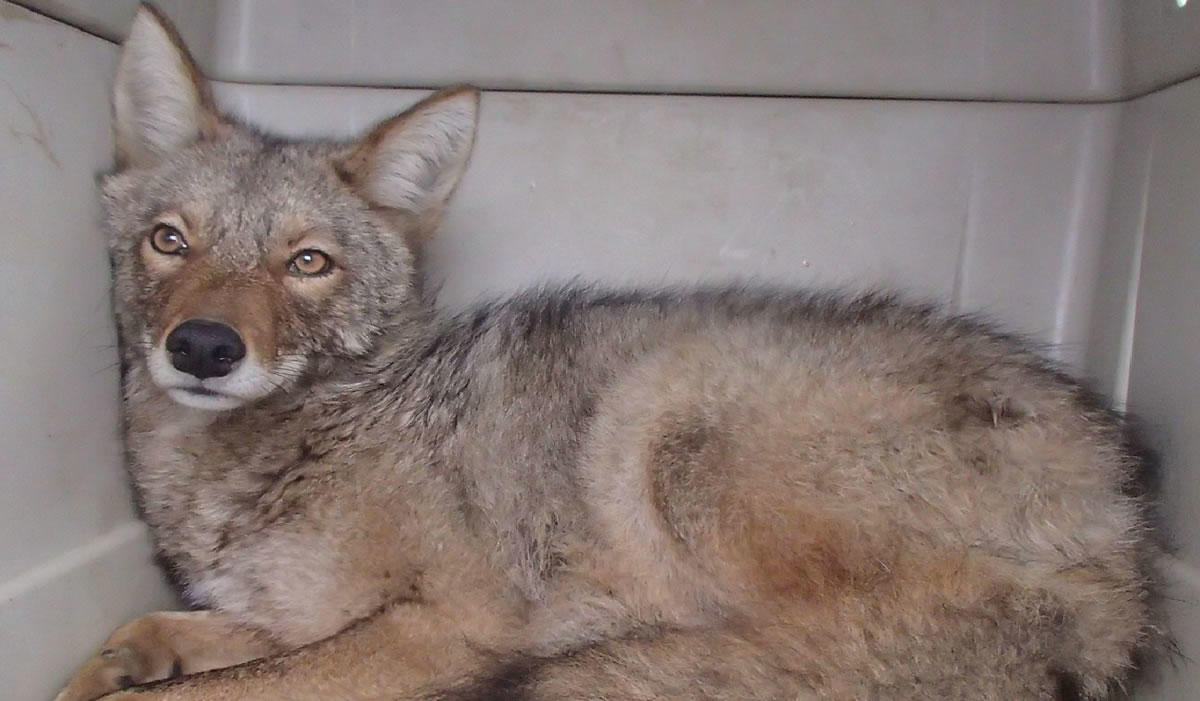
The coyote ahead of its release back into the wild. / photo: NYS DEC
Good news: The state Department of Environment Conservation says the coyote removed from the State Museum terrace Tuesday has been released back into the wild. There's a photo and video from the release below.
DEC says biologists at the agency's Wildlife Health Unit in Delmar checked out the coyote before the release Wednesday morning and concluded the animal was in good health.
As we noted yesterday, it's not all that surprising that a coyote would turn up around the Empire State Plaza -- they slip through urban and suburban areas often. But finding one hanging out in a place like that during the day is odd. So what happened?
There was a coyote at the State Museum

A photo posted by NYS Police on Twitter Tuesday.
A thing that happened Tuesday: A coyote -- an actual, living, wild coyote -- found its way up onto the terrace of the State Museum around noon.
State Police responded, and in turn called in the state Department of Environmental Conservation. DEC said that wildlife technicians tranquilized the coyote and took the animal to the agency's wildlife lab for evaluation. A DEC police lieutenant told the media it's not clear if the coyote was sick, but it had been become trapped and was scared. [@nyspolice] [@NYSDEC] [@bern_hogan]
Let's hope the coyote avoids the usual ending to the wild animal story arc. (RIP, Runaway Bison and Albany Bear.)
Coyotes among us
That a coyote would show up around the State Museum -- or anywhere in Albany -- is actually not that surprising. That it would end being noticed is more so.
Moose spotting
The state Department of Environmental Conservation is doing another aerial survey of the moose population in the Adirondack Park. And, of course, there are photos -- that's one of them above (more at the link).
See also: DEC's Flickr gallery of moose photos.
DEC says that early results point to the moose population being about 400 in the park.
Here's an info page on moose in New York, along with details about how to report a moose sighting.
By the way: moose are very big and strong and should be given plenty of distance.
Earlier:
+ There's a moose... and there's a moose... and there's a moose...
+ Mesmerizing moose
The Wild Birds of New York
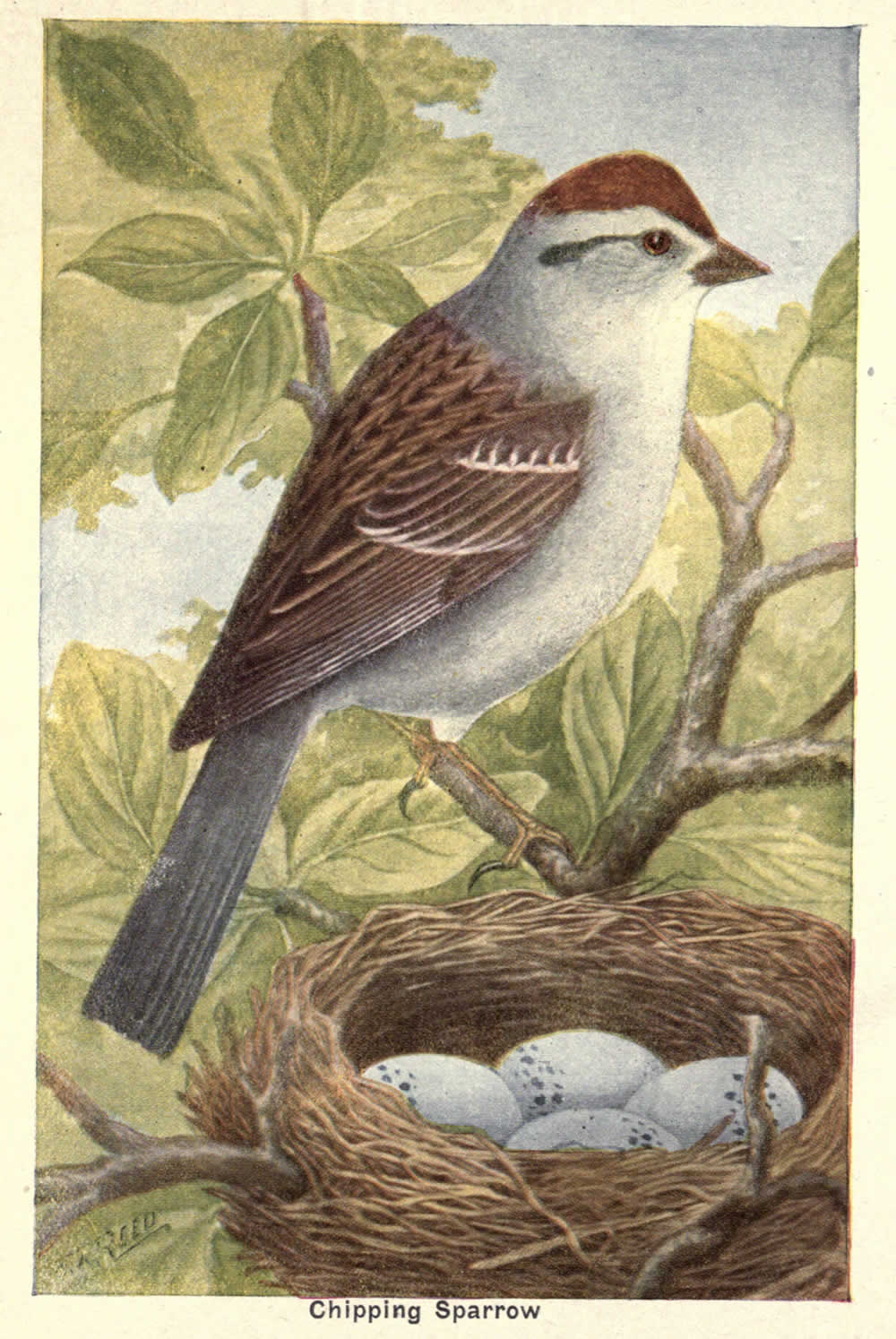
Blissfully removed from pretty much everything going on...
Check out this 1912 book Wild Birds of New York. It includes some lovely illustrations -- we've clipped a few as a samples (see below).
The book was the work of Chester A. Reed, who developed the idea of a field guide. (This particular book was released in conjunction with the Mohonk Mountain House.) And though he died at just 36 years old, he had a prolific career, publishing 24 books.
The crows -- and crow trucks -- are returning to Albany

The cold nights arrive. The leaves fall. And the crow dispersal trucks migrate back to the city of the Albany.
Identifying information for this species and its seasonal visits, from a city press release:
The dispersal will take place in the areas surrounding Hackett Blvd. and Sheridan Blvd. in Albany. The City of Albany requested assistance to scatter the crows because of their droppings and the ruckus they create.
The non-lethal dispersal will be conducted by wildlife biologists from the Animal and Plant Health Inspection Service, Wildlife Services, part of the U.S. Department of Agriculture. They will be driving marked vehicles and wearing uniforms and a yellow safety vest marked "USDA Wildlife Services."
The work will be repeated at two-week intervals throughout winter where roosts develop.
The non-lethal methods used to disperse crows include pyrotechnics, spotlights, non-harmful lasers, and recorded crow distress calls that are amplified. Several of these methods produce loud noises and flashing lights similar to sirens and fireworks that frighten birds and may be heard or observed by local residents.
Residents are strongly encouraged to place household trash in containers with lids to discourage crows from feeding. Residents may also use bright flashlights to disperse crows roosting in trees.
Look for the first sightings of the trucks in the evenings of November 20 and 21. They can easily be spotted with the naked eye, no binoculars needed. You may also learn to recognize their distinctive call if you listen for them.
Earlier:
+ A dossier on our crow invaders
+ A seasonal farewell to the crows
A look around the Mohawk Hudson Humane Society's new animal care center

The Mohawk Hudson Humane Society officially opened its new animal care center in Menands Wednesday. The newly-constructed $7 million project is 32,000 square feet -- about 50 percent bigger than the old center -- and a big step up in amenities.
The org could use the space -- its almost 50 staff members and hundreds of volunteers helped facilitate 3,776 pet adoptions last year, in addition to providing services such as spaying/neutering, dog training, and the Safe Haven program for the pets of domestic violence victims. The new facility can provide a temporary home for up to 200 cats at a time, along with 87 dogs, and an assortment of other small animals.
Here's a look around the new building...
Checking in on the Tivoli Preserve Community Farm sheep
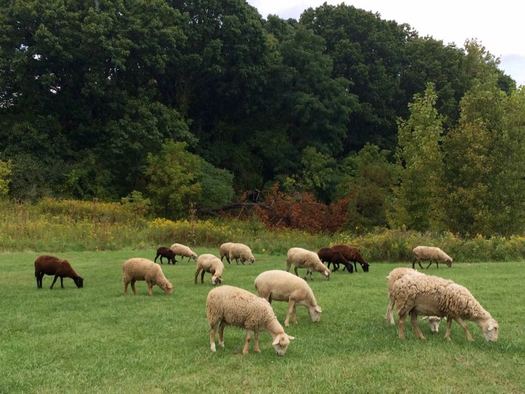
Yep, this is the city of Albany.
Among the newest residents of Albany's Tivoli Lake Preserve: sheep.
The small flock is there now as part of the Tivoli Preserve Community Farm project. The goal is to build a working farm and community programs in the park on the north side of Albany -- and there's been a lot of progress in recent months.
"It's just moving really quickly with help now," said Melissa Parade, the founder of the farm project, when we stopped by last week. "It feels really good."
Here's some quick follow-up on what's happening. And a lot of sheep pics.
The Cohoes Mastodon Park

A vintage postcard for the park. / image: Matt Malette/Albany Archives
It's Other Timelines week on AOA, in which we'll be looking at alternate histories of this place, about big and small things that did or did not happen.
This year marks the 110th anniversary of the official formation of the Cohoes National Wildlife Refuge -- or, as most people here call it, the Cohoes Mastodon Park.
So we thought it'd be interesting to talk with Laura Claverack, manager of the refuge, about the history of the park, charismatic megafauna, and what the future holds for the park's population of mastodons.
The return of the blue snowflakes
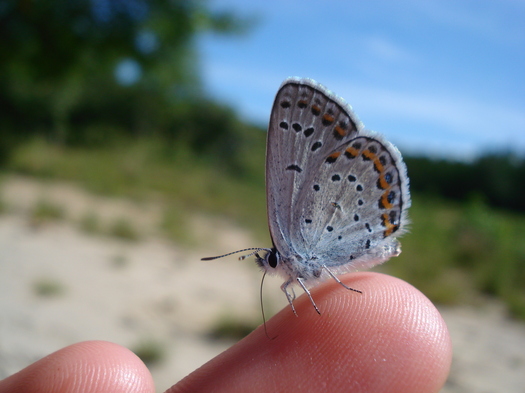
The Albany Pine Bush is an unusual example of an inland pine barrens, and it's one of the few homes to an unusual inhabitant: The tiny, beautiful -- and endangered -- Karner Blue butterfly. And it's making a comeback.
The Albany Pine Bush Preserve Commission announced Thursday that conservation efforts in recent decades have apparently had a big effect on Karner Blue populations in the Pine Bush. In 2007, the preserve was estimated to have fewer than 1,000 of the butterflies. And in 2016: more than 15,000.
Eagle eyes
DEC Wildlife staff recently banded a #baldeagle chick at a new nest in Schoharie County: https://t.co/5DCLDPNJDj #WildlifeWednesday pic.twitter.com/V1aIvULlqb
— NYSDEC (@NYSDEC) June 7, 2017
And now a short video clip of a bald eagle chick in Schoharie County that the state Department of Environmental Conservation posted on Twitter today because it's a short video clip of a bald eagle chick.
The chick was recently banded as part of a conservation program. DEC figures there are now more than 400 nesting pairs of bald eagles in the state. The birds were almost entirely gone from the state by the 1960s, but a program that started in 1976 relocated eagles from other states and helped reestablish populations here.
A good place to spot them in this area is along the Hudson River, at sites such as Peebles Island or Schodack Island.
Turtle time
 The state Department of Environmental Conservation would like to remind you that "the state's native turtles are on the move in May and June seeking sandy areas or loose soil to lay their eggs" -- and to urge people to watch out for them while driving. From a "What can I do to help?" list:
The state Department of Environmental Conservation would like to remind you that "the state's native turtles are on the move in May and June seeking sandy areas or loose soil to lay their eggs" -- and to urge people to watch out for them while driving. From a "What can I do to help?" list:
+ If you see a turtle on the road, please try to avoid hitting it with your car. Do not swerve suddenly or leave your lane of travel, but take care to avoid hitting turtles while driving to "give turtles a brake".
+ Be on the lookout for turtles and slow down, especially on roads near rivers and marshy areas.
+ If you see a turtle in the road or shoulder and you can safely stop your vehicle and approach the turtle, please consider moving it to the shoulder on the side of the road in the direction it is facing.
+ Picking the turtle up by its tail may frighten or injure it. Most turtles, other than snapping turtles, can be picked up by the sides of its shell.
+ Use extreme caution when approaching snapping turtles. You could:
+ stand watch as she finishes crossing,
+ pick her up at the rear of the shell near the tail using both hands, or
+ slide a car mat under the turtle to drag her safely across the road. See a video of how to help a snapping turtle cross the road (leaves DEC website).
+ Do not take the turtle home. All turtles native to New York are protected by law and cannot be collected without a permit.
There are 11 native species of land turtles in New York, according to DEC, which says the populations of each are in decline.
APD: Somebody is killing geese at Buckingham Pond
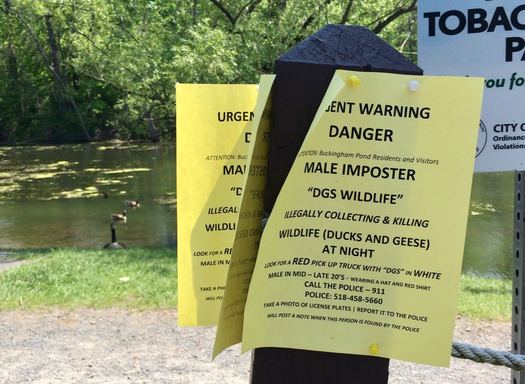
Updated Friday morning with comments from the APD spokesman.
So, this is weird... From a message from James Brooks in the Albany Police Department's Community Services Unit, distributed Thursday in an email from the Buckingham Lake Neighborhood Association:
APD has confirmed sightings of an unknown person killing geese that reside at Buckingham pond. Killing Canadian Geese is in violation of Federal Fish/Wildlife and NYS EcCon Law.
I ask that everyone keep a lookout to anyone who is in close proximity of these animals.
It is possible that the suspect is a white male dressed in a blue uniform operating a red newer model pick up with the lettering "DGS Wildlife" on the side.
If you see this suspect or vehicle at or about the park area notify the police immediately.
There are also flyers at the pond near the playground with similar info. That's one of them above.
Pup. Pup. Pup. Pup.
A red fox with her pups at their den in Canandaigua, NY. #WildlifeWednesday pic.twitter.com/GCkwzSoKtP
— NYSDEC (@NYSDEC) May 10, 2017
Not local exactly, but... awwww.
The state Department of Environmental Conservation shared this video clip on Twitter yesterday of red fox pups Canandaigua. The video was captured by a trail camera set up by Dennis Money. DEC also posted a bunch of still photos of the pups on its Facebook page -- you can see them getting bigger across the photoset.
Here's DEC's info page on red foxes. The agency reports that the animals are known to be in almost every county in the state, though their populations are under pressure from coyotes. "Expanding coyote populations (a potential predator of red fox) have pushed red fox further into residential areas in recent years."
Earlier: Coyotes in Albany
It's a hoot
Noted: The state Department of Environmental Conservation has an Instagram account.
It includes many good photos of birds (owls) and other animals (moose) from around the state.
That is all.
Coyotes in Albany
 The city of Albany announced Wednesday it's posted coyote warning signs in the area of the Capital Hills golf course and Normanskill Farm following word from residents of recent coyote sightings. (The properties are adjacent to each other along the Normanskill on the city's southern edge.)
The city of Albany announced Wednesday it's posted coyote warning signs in the area of the Capital Hills golf course and Normanskill Farm following word from residents of recent coyote sightings. (The properties are adjacent to each other along the Normanskill on the city's southern edge.)
That's a sign image the city distributed. From a city Department of General Services press release:
Residents and dog owners should be mindful of coyotes when walking dogs in the neighborhood and letting dogs out in their yards. Coyotes are wild animals and they can be dangerous. Do not encourage them to approach or feed them. If you bring your pets to Capital Hills they MUST be kept under direct control for your safety and the safety of the animals.
If you see a coyote exhibiting "bold" behaviors and showing little or no fear of people, contact the local New York State Department of Environmental Conservation at 518-357-2355.
As we've mentioned before, coyotes -- specifically eastern coyotes -- have been moving into New York over the last century and seemingly popping up more frequently in this area in recent decades. The Pine Bush is a hot spot for them, and as the city noted today, they show up at Capital Hills, too. (Otto and a friend saw a coyote there one time and it was very exciting.)
Today's moment of winter
One of the cool things about woolly bears: They're able to freeze and thaw over the course of a winter -- and still survive.
Oh, and the myth/tale/conjecture about woolly bears being able to predict the severity of a winter? It started in the Hudson Valley.
Early morning swim
In other news: Squirrels can swim. And this squirrel was swimming in Washington Park Lake Saturday morning as the fog lifted.
In other other news: WHAT?
(Thanks, Laura!)
Caw. Caw. Caw.

With the return of cold weather, the huge flocks of crows that roost in urban areas have also show up. And once again there is an effort to disperse them.
The USDA trucks are set to start rolling through the city of Albany November 16 and 17 in the late afternoon and early evening. From a press release:
The non-lethal dispersal will be conducted by wildlife biologists from the Animal and Plant Health Inspection Service, Wildlife Services, part of the U.S. Department of Agriculture. They will be driving marked vehicles and wearing uniforms and a yellow safety vest marked "USDA Wildlife Services." The work will be repeated at two-week intervals throughout winter where roosts develop.
The non-lethal methods used to disperse crows include pyrotechnics, spotlights, non-harmful lasers, and recorded crow distress calls that are amplified. Several of these methods produce loud noises and flashing lights similar to sirens and fireworks that frighten birds and may be heard or observed by local residents.
Residents are strongly encouraged to place household trash in containers with lids to discourage crows from feeding. Residents may also use bright flashlights to disperse crows roosting in trees.
The crows can cause problems, as the press release notes, "because of their droppings and the ruckus they create." But we've come to appreciate their presence in winter -- they make the city feel more alive somehow. And there's some beauty in watching the flocks cross the sky at dusk.
Also: Crows are very smart. And maybe having a good relationship with them will pay off during the inevitable avian uprising.
Dog power

For dogs. Or sheep. / photo via State Museum
Last week we mentioned the State Museum's upcoming "Kids Curate" exhibit, for which kids can vote online about which items like they'd like to see featured.
And among those items was one that caught our eye: a treadmill for dogs. Apparently other people found this interesting, too.
So, here's a little bit more about that dog-powered treadmill.
Animal walk-and-talks at the Pine Bush
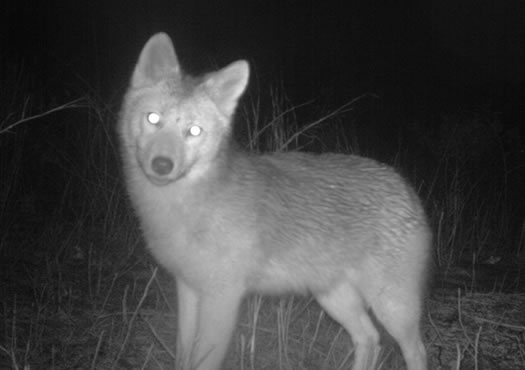
This photo was captured by a camera trap in the Pine Bush a few years ago.
There are all sorts of animals that either live in, or make their ways through, the Albany Pine Bush: coyotes, porcupines, foxes, fishers, deer, and so on.
The Albany Pine Bush Discovery Center has a bunch of family-friendly talk-and-walk programs about these animals coming up over the next month...





... said KGB about Drawing: What's something that brought you joy this year?